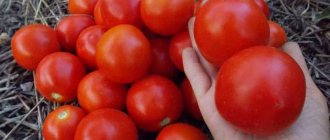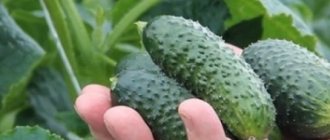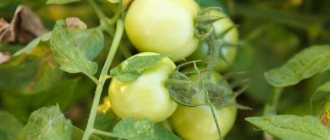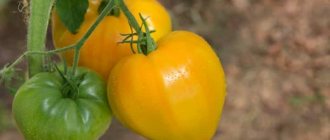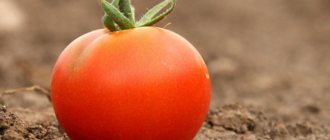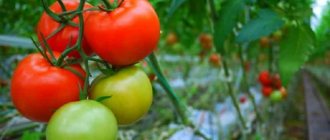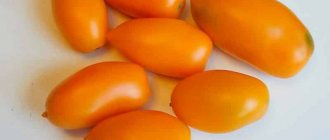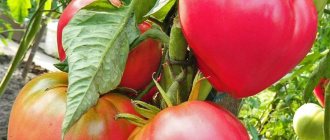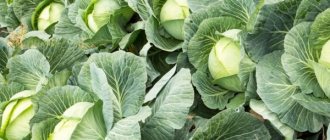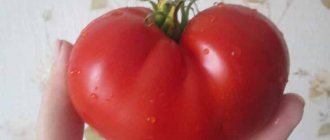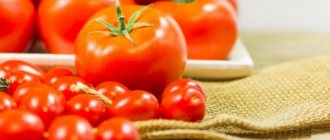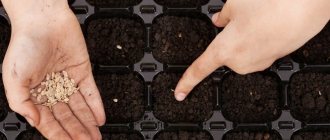Description and characteristics of Liana tomato
The characteristic features of the Liana variety are determined by its physiology.
Appearance
The plant is determinate, the growth of the main stem is limited to several flower clusters. This feature contributes to the formation of a compact bush with strong stems 50–60 cm high. The Liana tomato variety does not branch much, the leaves are small but numerous. One stem bears 2–3 fruit clusters of 6–7 fruits each. The tomatoes are smooth, beautiful, dense, resistant to cracking, round in shape, weighing 50–80 g. The peel is smooth, there are few seeds and seed chambers.
History of selection
The Lyana variety was developed in Moldova. Breeders from the Transnistrian Agricultural Research Institute have developed an early, productive variety that quickly yields crops with good commercial qualities. It has low production costs and traditional technology.
Expert opinion
Stanislav Pavlovich
Gardener with 17 years of experience and our expert
Ask a Question
The red-fruited variety Lyana is the most widespread, but due to interest in pink fruits, a larger and more stable hybrid has been created - Lyana pink. It has similar characteristics, but the sugar content of the fruit in the hybrid variety is higher, and the size is larger and reaches 100 g. The main color of the tomatoes is pink or crimson with a pink tint.
Productivity and fruiting
Liang's tomato begins to ripen in less than 90 days from the time of sowing. Under unfavorable conditions, fruiting may occur a little later - after 95–110 days, but earlier than in many determinate varieties.
One bush in open ground produces about 4 kg of tomatoes; in a greenhouse with 1 m2, up to 8 kg of tomatoes are harvested.
Suitable region and climate
Thanks to its early ripening and stability, the Lyana tomato variety is widespread in many regions of Russia, even Siberian, Belarus, and the Baltic states. The seedless cultivation method is also suitable for the south of Russia and Ukraine. But most often the seedling method of cultivation is used. In the north of the country, tomatoes are grown in protective structures.
Resistance to diseases and pests
The variety has average resistance to major viral and fungal diseases. Early ripening periods save the situation, which allows harvesting before the spread of late blight and septoria. But it can be difficult to preserve the harvest without preventative measures in cool, rainy conditions.
Expert opinion
Stanislav Pavlovich
A gardener with 17 years of experience and our expert. See also: Productivity and description of the tomato variety Makhitos f1 - recommendations for growing
Ask a Question
Advice! Early planting of Liang tomato seedlings in the ground attracts the Colorado potato beetle, so the situation must be monitored regularly.
Description of tomato variety Lyana
Despite the fact that the Lyana variety was bred in Transnistria, the State Register of Breeding Achievements of the Russian Federation, where it was registered in 1996, recommends it for cultivation mainly in the Central and East Siberian regions. Of course, this does not mean that Liana will not grow in the truly “tomato” Volga or Black Earth regions. The variety is successfully cultivated throughout almost the entire territory of our country; these tomatoes are also planted in neighboring Moldova and Ukraine.
The Liana tomato belongs to the determinate varieties: its bush is not tall (no higher than 40 cm), but it also does not look like a tree, that is, it is not standard, its branching is average, and the bushes grow a lot of leaves. These leaves are of normal size and color, slightly corrugated. The first inflorescence is already formed above the fifth or sixth leaf, and then new ones appear every 1 or 2 leaves. In total, at least five clusters are formed on the bush, each of which contains 4–5 tomatoes.
The Liang tomato bush is not tall, but, unfortunately, its stems are very fragile and break off without tying them up
The fruits are small, weighing about 80 g, round, red in color, with two or three seed chambers. The taste of fresh tomatoes is considered excellent. Directions for their use are fresh consumption and whole-fruit canning. When preparing for the winter, tomatoes do not crack; they look very appetizing in jars. You can make both juice and tomato paste from these tomatoes; at least, the rich chemical composition is quite favorable for this.
Tomatoes ripen quickly and early: in the middle zone about 100 days after germination, that is, approximately in the middle of summer, in Siberia a week and a half later. The yield is not bad: about 3 kg of tomatoes are harvested from each bush in the middle zone. Oddly enough, the yield in Siberian conditions is one and a half to two times higher. Tomatoes easily tolerate transportation over any distance, despite their thin skin. Under suitable conditions, tomatoes can be stored fresh for about two months.
The variety is highly resistant to most diseases; resistance to late blight is assessed as average, and to tobacco mosaic - below average. It is able to grow well both in greenhouses and in unprotected soil, but mainly, like other low-growing varieties, it is grown outside greenhouses. Some hobbyists plant several bushes even on the balconies of city apartments.
In climatic regions that are not too harsh, it is practiced to plant the Lyana variety without growing seedlings, but in this case, the fruits ripen only at the end of summer.
Based on the red tomato Lyana, a new variant has been developed - Lyana pink. The main characteristics of these two varieties are the same, but the updated version ripens somewhat faster and can even be classified as ultra-early. In addition, pink tomatoes, which are slightly larger, have a higher percentage of sugar content.
Video: description of Liang's tomato
Specifics of growing the variety
Agrotechnical measures for cultivating the Lyana tomato variety are quite simple and traditional for determinate plants.
Sowing seeds for seedlings
Specific sowing dates are determined taking into account the expected date of planting seedlings in a field or greenhouse. It is taken into account that the age of seedlings suitable for planting is 50–60 days.
Expert opinion
Stanislav Pavlovich
Gardener with 17 years of experience and our expert
Ask a Question
Advice! Sowing dates can be coordinated with the recommendations of the lunar sowing calendar.
The timing of sowing is influenced by weather conditions and the presence of a protective structure. Ready-made purchased soil does not need to be processed, but the garden soil is heated in the oven or spilled with a disinfecting solution of potassium permanganate or fundozol.
Self-produced seeds are disinfected in a slightly pink solution of potassium permanganate for 30 minutes and sown in shallow, sterile containers.
Before sowing, the soil is compacted and well moistened. The seeding depth is no more than 1 cm. To retain moisture, cover the container with glass or transparent film, ventilate regularly, and remove condensation:
- Until the seeds germinate, maintain a temperature of +25 ºС.
- After the entrances appear, the temperature is reduced to +14…+16 ºС, the lighting is increased, and the shelter is removed.
- After a week, the temperature regime during the day is set at +20...+22 ºС, at night the temperature is lowered by 2–3 degrees.
Optimal humidity is maintained, watering is carried out at the root with warm, settled water.
Attention! Low lighting can cause seedlings to stretch out and reduce seedling quality.
Seedling care
Seedlings in the phase of 1–2 true leaves are dived into separate deep containers measuring at least 8x8 cm. The root is pinched when picking. Agrotechnical techniques allow you to increase the feeding area and form a good root system.
The best predecessors
The Liana tomato cannot be grown after nightshade crops: peppers, tomatoes, eggplants, potatoes, which have the same pests and diseases. It is better to choose cabbage, beans, legumes and forage grasses as predecessors. Crop rotation is the main point of disease prevention.
Transplanting a tomato to a permanent place
They begin planting seedlings in the ground with the onset of consistently warm weather. Tomatoes of the Liana variety love a lot of light and warmth, and the site is chosen according to this. High beds are prepared two weeks before planting, filled with humus and mineral fertilizers. 4–5 plants are planted per 1 m2. Planting scheme: 60x40 cm, 60x60 cm.
See also Description, characteristics and features of growing Pink Giant tomato
Diseases and pests
Most often suffers from tobacco mosaic. The first signs of the disease are the appearance of variegated dark and light spots on the leaves. This disease is caused by a lack of light. If the damage is severe, the plant cannot be cured. It must be destroyed.
To prevent infection, it is necessary to treat the seedlings with a solution of boric acid a couple of days before planting and provide good lighting. Lyana has firmly won the love of many amateur gardeners. This wonderful variety does not require much effort to grow. After all, if you follow the rules of agricultural technology, you can get a good harvest of early, very tasty and healthy tomatoes.
Further care of the crop
Agrotechnical care measures are traditional: watering, fertilizing, weed removal.
Features of watering
The soil is kept moist, but not wet, as excessive moisture creates the preconditions for disease. Watering is carried out with warm water. It is necessary to moisten the entire area to the width and depth of the root system, without exposing the roots.
Important! Leaves should remain dry when watering.
You need to water as the soil dries out, depending on the weather, 1-2 times a week.
Fertilizers
The soil is well-dressed before planting, then during the growing season you will only need a couple of fertilizings. For the first feeding, a solution of mullein or vermicompost is more suitable, for the second - a complex of mineral fertilizers with a predominance of phosphorus and potassium. Apply fertilizers during watering
Expert opinion
Stanislav Pavlovich
Gardener with 17 years of experience and our expert
Ask a Question
Advice! It is advisable to carry out several foliar small-drop fertilizing with microelements on the leaves of the plant.
Bush formation
Liana grows poorly in open ground and does not need to be formed. If the area is over-dressed, and the weather is warm and humid, the green mass grows quickly, then the stepsons have to be partially removed. 2-3 stems are left in protected ground and attached to a support. To prevent thickening of plantings and speed up ripening, some shoots and leaves have to be removed.
Pest and disease control
The main measures to prevent the development of diseases are the following preventive actions:
- keeping the site, greenhouse, and work equipment clean;
- timely removal of weeds, damaged leaves, plants with signs of disease;
- avoid excess moisture;
- plant plants next to tomatoes that repel disease carriers (aphids, ticks);
- treatment of seedlings with bromine solution and copper-containing preparations.
Use and application
Tomatoes for universal use. Therefore, they can be consumed not only fresh, but also used for canning and pickling. These tomatoes are also delicious sun-dried and dried.
They are excellent for whole canning, as due to their thick skin they do not crack. Due to their sweetish taste, they are recommended to be added to salads and combined with other vegetables and herbs.
Watch the video! Tomato Liana
The fruits of the Lyana variety are universal, they can be used fresh for salads, when preparing various dishes, and they are also very easy to pickle. When salting tomatoes, their skin is not susceptible to cracking, which is why they will look very beautiful and appetizing even when salted.
As mentioned in the description above, Liang tomatoes contain a large number of useful elements, which is why they are often used to prepare food for children - so that they receive a high dose of vitamins, carotene and ascorbic acid.
Tomato variety Liana: about the advantages and disadvantages
Among the advantages of this variety are the following:
- Unpretentiousness to growing conditions.
- Great taste.
- Precocity.
- High immunity to most nightshade diseases.
- Suitability for transportation and long-term storage.
Flaws:
- Susceptibility to some nightshade diseases.
- It is not economically effective when grown in protected soil.
Tomato pink Lyana: photo
When studying the characteristics of a variety, it is important to talk about both positive and negative qualities; only after weighing all the pros and cons, you can make the right choice: to plant this variety on the site or not. If we talk about the advantages, then gardeners highlight the following: the plants are very unpretentious, they are easy and simple to grow, the taste of the fruits is excellent, and the yield is very high, in addition, the fruits appear very early, so you can enjoy a salad of fresh tomatoes at the beginning summer.
Liang tomatoes bear fruit more than once, so tomatoes ripen until late autumn. It should also be said that plants are quite resistant to diseases and pests, so preventive treatments are often not necessary. If we talk about shortcomings, we will immediately note: there are not so many of them. The pink tomato Lyana is a heat-loving crop, so it will not bear fruit in harsh climatic conditions, remember this.
While noting the advantages of the Liang tomato, we forgot to mention the good preservation of the product; tomatoes of this variety can be transported over long distances and will not spoil. Even ripe fruits do not lose their beautiful appearance, so you can rest assured about the safety of your tomatoes. But it should also be said that the green mass of plants is quite voluminous, so foliage will have to be removed even on the side shoots, but these are just nuances; a rich harvest compensates for everything.
